There’s no better way to enjoy the sights and fragrance of cherry blossoms than to be right among them!
 “View to the North from Asukayama” from Utagawa Hiroshige’s woodblock print series, One Hundred Famous Views of Edo. This spot was visited by the 13th Shōgun, Tokugawa Iesada two months before the print was published. Print produced by Takahashi Kōbō.
“View to the North from Asukayama” from Utagawa Hiroshige’s woodblock print series, One Hundred Famous Views of Edo. This spot was visited by the 13th Shōgun, Tokugawa Iesada two months before the print was published. Print produced by Takahashi Kōbō.
What is ohanami?
Springtime in Japan often brings to mind the image of Japanese cherry blossoms called sakura. Sakura season draws many tourists from both around the country and around the world to Japan’s many famous cherry blossom-viewing spots. Among the beautiful blossoms, people enjoy ohanami, which translates to simply mean flower viewing, but also includes the contemplation of cherry blossoms. You can see people enjoying ohanami in Asukayama Park in the Edo period (1603-1868) woodblock print above. There is no better way to enjoy sakura than to sit beneath the blossoms with good food and good company!
Are you ready to try ohanami? Take a look at our easy 4-step ohanami guide below to enjoy cherry blossoms the Japanese way!
Step 1: Appreciating the meaning of sakura
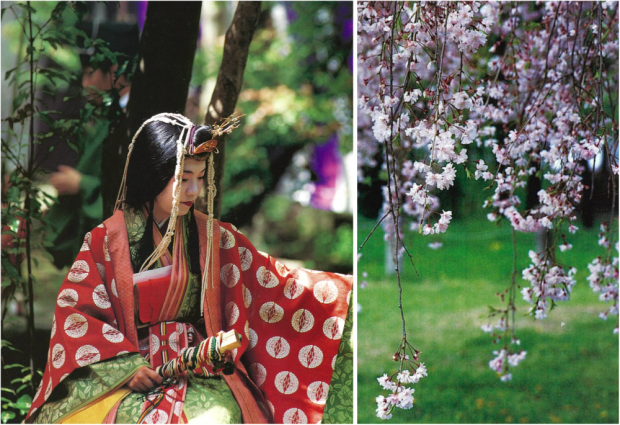 (Left) A Heian period-style cherry blossom-viewing banquet at Kamo Shrine in Kyoto. (Right) Weeping cherry. Photographed by Takahashi Noboru.
(Left) A Heian period-style cherry blossom-viewing banquet at Kamo Shrine in Kyoto. (Right) Weeping cherry. Photographed by Takahashi Noboru.
How did the custom of ohanami start? In the beginning, people held feasts under the blooming sakura to celebrate the gods of the rice harvest. You may be wondering, “how are cherry blossoms and rice connected?” The appearance of cherry blossoms signaled the seasonal transition from winter to spring, and shortly after it would be time to plant rice. It was believed that the harvest gods dwelled among the sakura, and when mountain cherry began blooming in the hills and slowly transitioned down towards the fields, it appeared as if the harvest gods were moving down from the mountains to work their magic in the rice fields below.
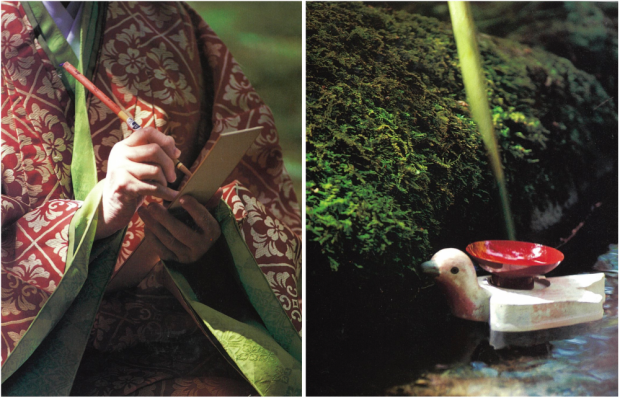 (Left) A woman writes poetry at a cherry blossom-viewing banquet held at Kamo Shrine in Kyoto. (Right) Cups of sake float on bird-shaped vessels. Photographed by Takahashi Noboru.
(Left) A woman writes poetry at a cherry blossom-viewing banquet held at Kamo Shrine in Kyoto. (Right) Cups of sake float on bird-shaped vessels. Photographed by Takahashi Noboru.
To honor the deities of their crops, Japanese people would hold ritual feasts under the canopy of sakura in the presence of the gods. Though the food was intended for the gods, people would also dine and drink while requesting a bountiful harvest. The Japanese aristocracy turned the appreciation of cherry blossoms into an art and contemplated the fleeting nature of sakura, of beauty, and of life at elaborate flower-viewing banquets while drinking, feasting, and composing poetry. Nobles and poets would set out on excursions too, to seek out famous and new places to enjoy sakura.
In the Edo period, this custom became more of a leisurely outing enjoyed by all levels of society. Nowadays, people look forward to ohanami parties with friends, coworkers, or family.
Step 2: Pick a spot!
 People enjoying lunch-time ohanami at Rinko Park in the Minato Mirai district of Yokohama.
People enjoying lunch-time ohanami at Rinko Park in the Minato Mirai district of Yokohama.
Throughout Japan there are many places both famous and secretive ones only locals know, that boast incredible views of sakura. It is helpful to do a little research! If you will be in the Tokyo area in the beginning of April, we have prepared a list of 5 popular spots to enjoy cherry blossoms, which you can see here. (Please note that it is not possible to picnic at all of these locations.) On the other hand, if you will be in the Kansai region around Kyoto, Nara, Osaka, and so on in early April, we introduce 5 places to enjoy blooming sakura against beautiful castles, temples, and shrines.
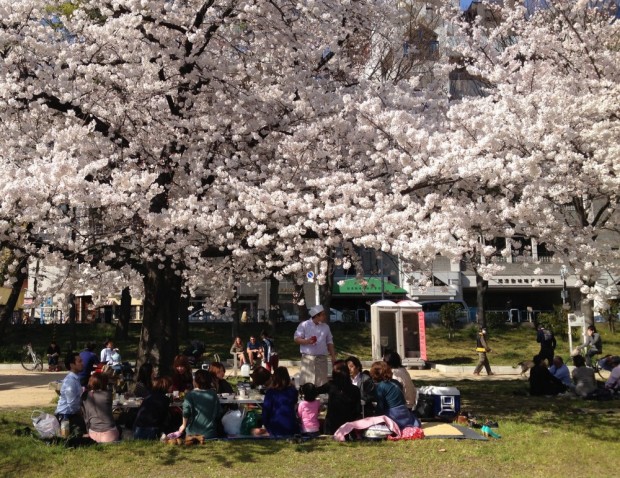 Weekend ohanami at Kema Sakuranomiya Park in Osaka.
Weekend ohanami at Kema Sakuranomiya Park in Osaka.
Be sure to check the estimated peak time of places you want to visit, such as the sakura forecast offered by the Japanese Meteorological Corporation. Though sakura are often associated with early April, that holds true for the central areas of Japan. If you arrive in Japan in March, Kyushu and Shikoku will be at peak season, whereas the northernmost Tohoku areas and Hokkaido will be at peak sakura season in late April and May.
Step 3: Prepare for your picnic.
 Famous Tokyo ohanami treats from longstanding shops: Kototoi dango shop’s sweet dumplings, Chomeiji’s sakura mochi, and Kiku-no-i’s ohanami bento available for 1,050 yen. Photographed by Hiroshi Okabe.
Famous Tokyo ohanami treats from longstanding shops: Kototoi dango shop’s sweet dumplings, Chomeiji’s sakura mochi, and Kiku-no-i’s ohanami bento available for 1,050 yen. Photographed by Hiroshi Okabe.
Ohanami of course are held to view the flowers, but enjoying food and drink among companions make the experience all the more pleasant. In fact, there’s a Japanese proverb called “hana yori dango,” which translates to mean “dumplings over flowers.” The proverb refers to ohanami and how some prefer the practical over the aesthetic.
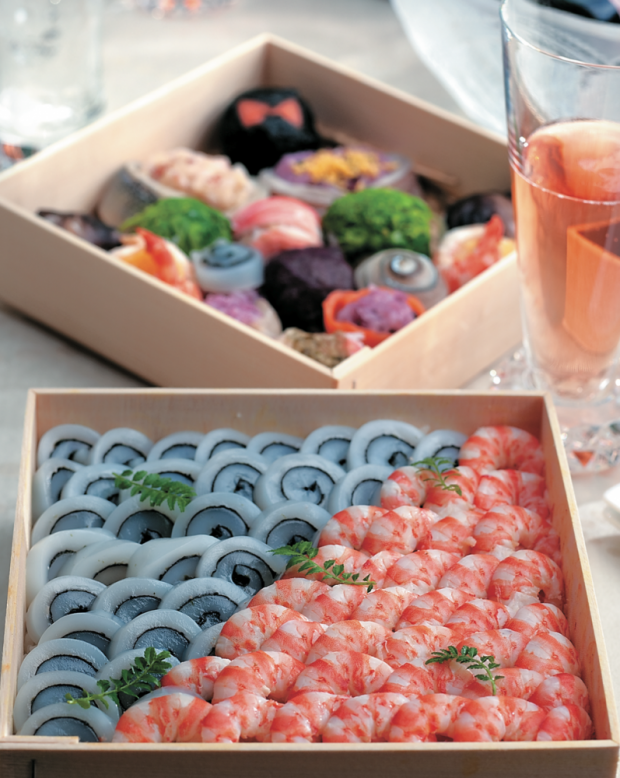 A fancy ohanami bento with rosé champagne offered by Sushi Aoki in Tokyo. Photographed Hiroshi Okabe.
A fancy ohanami bento with rosé champagne offered by Sushi Aoki in Tokyo. Photographed Hiroshi Okabe.
If you’ll be enjoying ohanami picnic-style and not just strolling through the trees, then bring ample food, drinks, and snacks, especially if you plan on staying out for several hours. Ohanami bento usually comprise of colorful, bite-sized foods such as sushi, yakitori (meat on skewers), dango (sweet dumplings on a stick), onigiri (rice balls), and more. Department stores offer pre-made seasonal bento boxes that are a delicious and compact option.
You will also need a tarpaulin sheet or portable chair(s) upon which to sit, and it is advisable to bring some plastic bags as well for garbage.
Step 4: Enjoy! But be respectful.
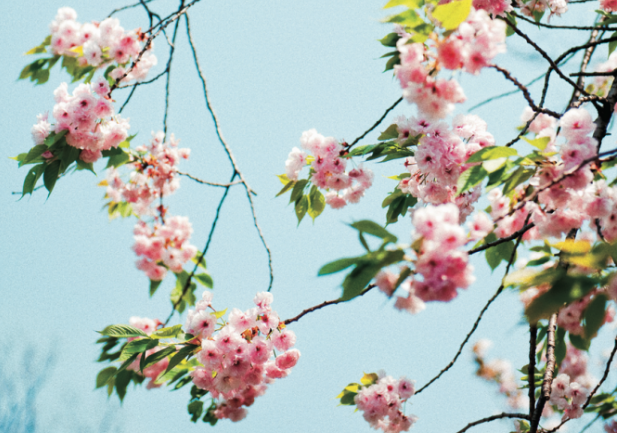 Cherry blossoms at Chidorigafuchi taken by Homma Hiroshi.
Cherry blossoms at Chidorigafuchi taken by Homma Hiroshi.
With your place set, food and drink ready, it is time to enjoy ohanami and the beauty of sakura! There are just a few things to keep in mind.
First of all, if you have selected a popular ohanami spot, get there early to claim a space for yourself or group! Parks can fill up very quickly.
Second, do not litter. Garbage cans may or may not be provided. Please sort your trash, and bring it home if services are not provided. This is one reason why it is a good idea to bring some plastic bags along!
Finally, though you may be tempted to bring some beautiful cherry blossoms home, please do not break off any branches as it is quite damaging to the tree. Sakura trees are actually rather delicate. In addition, the medieval Japanese monk Kenkō Yoshida, who was an expert on the beauty of Nature and impermanence, wrote in his collection of essays known as “Tsurezuregusa” (“Essays in Idleness”) that only boorish people would act so tastelessly as to tear off cherry blossoms from the tree. No one wants to come off as rude, so if you admire sakura, please do so with care and take only fallen blossoms and petals.
Written by Jennifer Myers.












